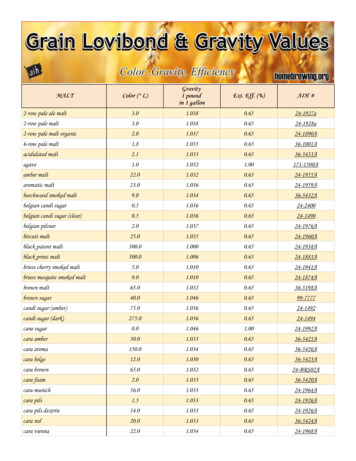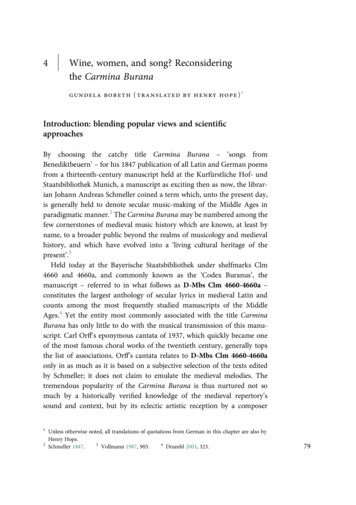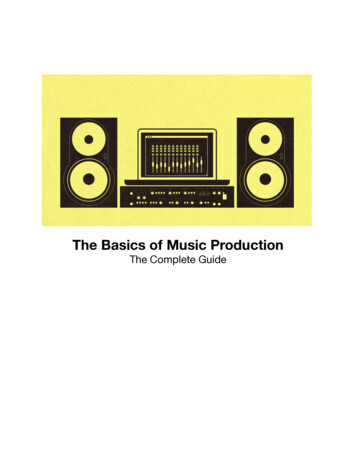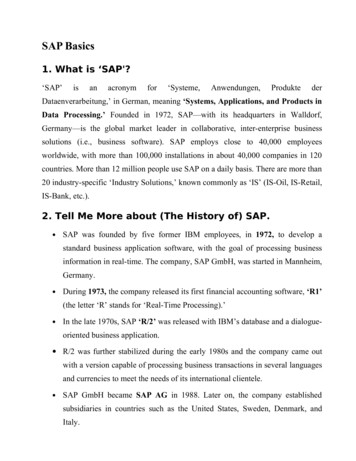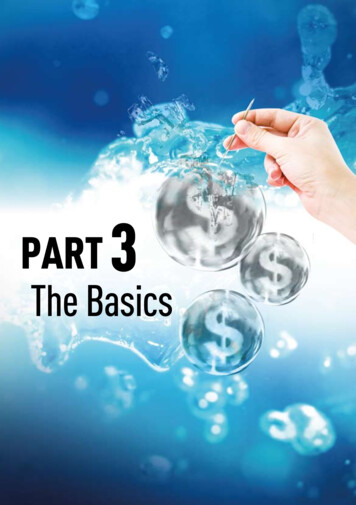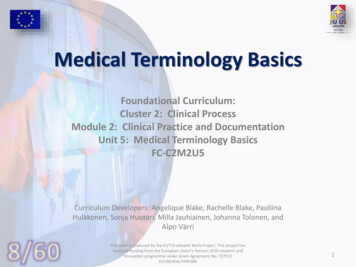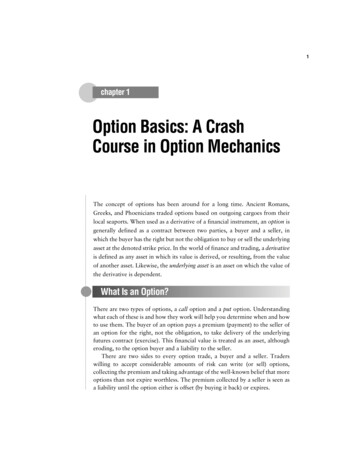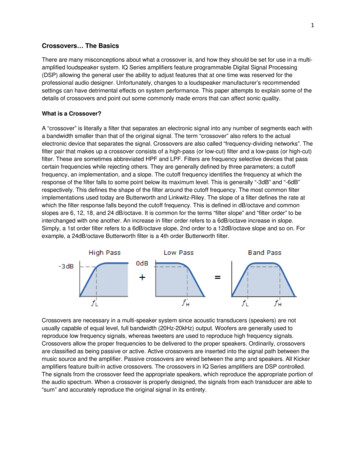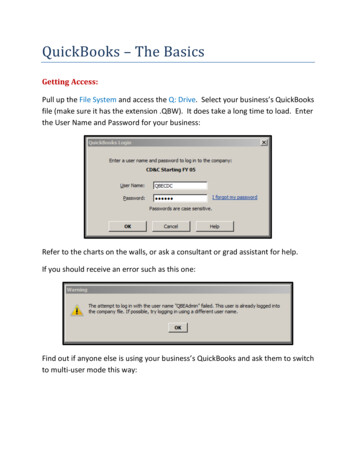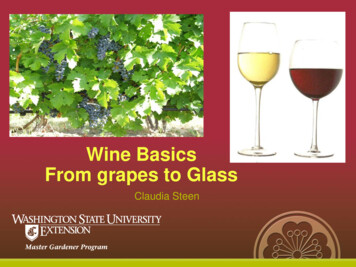
Transcription
Wine BasicsFrom grapes to GlassClaudia Steen
DefinitionsViticultureThe science and business of growingwine grapes Vigneron - Cultivator of grapevines / wine maker Vitis vinifera – wine grape(Genus/species)Enology The science of wine production Enologist (vintner) - wine maker Enophile - someone who enjoyswine
History of wine Earliest wine 8000 BC inMesopotamia 2500 BC - Egyptians Greek & Romans worshiped a godof wine Bacchus – Roman Dionysus - Greek Wine is referred to in the Bible Middle Ages - monks took theancients' knowledge of winemakingand refined it
History of WA wine grapes First vines planted in WA state in 1825Fort Vancouver – Hudson Bay Co. 1860 in Walla Walla Dr. Walter Clore – father of Washingtonwine 2014 statistics – WA Wine Commission 50,000 acres in production 40 varieties planted 350 grape growers 227,000 tons of grapes harvested 890 wineries 16 million cases of wine produced 4.4 billion dollar industry53% white wines47% red wines
Health Benefits of Wine Wine, in moderation, is a healthbenefit: decreased incident of heartattacks & strokes (the Frenchparadox) reduce tumors block formation of amyloidalplaques which contribute toAlzheimer's better dental health, etc Flavonoids - Anthocyanin in grapeskin give red color decreases cholesterol Rich in antioxidants
Health Benefitsof Wine Resveratrol – a class ofantioxidants known aspolyphenols Found in tannins in grapeskin, seeds, stems Is produced by plants toward off fungal infectionsand other diseases
WINE IS MADE IN THE VINEYARDWine grape growing primarilybetween 30-50 degrees latitude 50 degree - cool climate winecharacteristics6-7 months to ripen, acid, sugar (alcohol), lighter color, notas fruit forward, more delicatebody 30 degree - warm climate winecharacteristics4-5 months to ripen, acid, sugar, deeper color ( skin topulp ratio), fuller body, more fruitforward
Areas of the World with highest wine productionUSA production#1 – California#2 – Washington#3 – New York
TerroirSense of placeFrench for terre – land Influenced by: geography geology (soil type) Mosel region - blue slate Champagne region –limestone Yakima Valley – Missoulafloods climate (water,sunlight, temperature) plant genetics microclimates
Appellations Unique growing regionsOld World - Europe & Mediterranean can have mineral notes Burgundy, Loire,Champagne, Bordeaux in France wines often labeled by region Chablis Chardonnay Chianti Sangiovese Sancerre Sauvignon BlancNew World - All other areas (green) S A (Chile, Argentina), South Africa,America (CA, WA, OR, NY), Australia, NZ wines often labeled by the grape varietal Cabernet, Chardonnay, Riesling
Appellations AVA - American Viticulture WA state has 13 appellations Yakima Valley - 1983Walla Walla Valley - 1984Columbia Valley 1984Puget Sound - 1995Red Mountain - 2001Columbia Gorge 2004Horse Heaven Hills - 2005Wahluke Slope - 2006Rattlesnake Hills - 2006Snipes Mountain - 2009Lake Chelan - 2009Naches Heights - 2011Ancient Lakes - 2012Area
In the Vineyard Grape harvestPicked when grapes ripeapproximately 24 brix of sugar Read in refractometer(hydrometer) measures totalsolids in a solutionGlucose or fructose plus yeastconverts to ethanol plus carbondioxide during fermentationC6H12O6 yeast 2 CH3CH2OH 2 CO2 2 brix 1% sugar 1% alcohol
In the Vineyard AcidsPicked when grape pH isapproximately 3.2 - 3.4 found in thegrape berry pulp Other indicators of ripeness Leaves turn brown andphotosynthesis slows or stops Seeds inside go from greentinge to brown Squeeze berry, pulp is juicy &tastes good!
Lab report on “must”Acids - giveswine body andstructure Titratable acidity (TA) pHL - Malic acid - harsheracidTartaric acid - theprincipal acid in grapespromotes flavor and agingin wineLactic acid - softer acid
Harvesting the grapes Can be hand picked or machine picked Snips remove grape cluster to bucket Place full buckets into bins
At the Winery Bins transported to the winery Grapes loaded into stemmer /crusher Stems are removed and discardedWhite wine Juice is pressed away from the skin& seeds Juice goes into stainless steelfermentation tanks Rose' wineOften use red grapes Juice is pressed away from theskin & seeds Imparts a pink color and thentreated like white wine
At the WineryJuice with skin and seeds is called"must“ Red wineMust goes into large vats forinitial fermentation Yeast (Saccharomycescervisiae) is added Cover with cloth (to keepout fruit flies) Punch down cap daily(skins float - seeds (pips) goto the bottom) Smell is wonderful!
Types of Wine Still Cabernet – King of wine Chardonnay – Queen of wine Sparkling Champagne - France Cava - Spain Proseco - Italy Fortified (brandy) Port – Ruby, Vintage, Tawny Sherry
Wine grape VarietiesNoble grapes – mostpopular, grown worldwide Whites Riesling Sauvignon blanc Chardonnay Reds Pinot NoirMerlotCabernet SauvignonSyrah (Shiraz) Many other varieties
Wine Production Red wineAfter initial fermentation thewine is pressed off skin &seeds Can have secondarymalolactic (ML) fermentation(Lactobacillus bacteria) The harsher malic acid ischanged to the softer lacticacid One bi-product is Diacetylwhich gives a buttery flavorand enhances complexity Placed into Oak barrels ormaturation tanks Budding in the spring
Wine Production White or Rose wine Continue fermentation incooled stainless steel tanks Fermentation changessugar to alcohol White/Rose wines - can stopfermentation process ifresidual sugar desired or zeroif dry Red wines often fermentedto zero sugar
Maturation Process Racking overTake wine off the top and place into another vessel- leaving the "lees" or sediment (dead yeast, seeds,grape solids) Most reds (some whites) put into Oak barrels forbarrel maturation Coopers cut oak staves and construct barrel
Barrels are toasted Toasting (carmelization) of the woodimparts flavors to the wine Barrel flavors only lasts 2-3 years Vanillin (phenolic aldehyde)C 8 H 8 O3 Lactones (coconut) Phenols a perceived sweetness Spice notes, Leather, few tannins Can choose degree of toasting Light - LT Med – MT Heavy – HT Now can get oak chips to add to winein neutral barrels
Maturation Process Types of Oak American Oak - stronger flavors French Oak - tighter grain, betterquality Hungarian Oak - not as strong flavorsas American Neutral Oak – used in primaryfermentation or maturation where littleoak is required Topping off Oak is porous and water evaporates need to add wine to head space todiscourage oxidation
Wine ready for bottlingFiltering in order to clarify wine Fining done with White wineegg whites capture solids White/Rose often consumedwithin 2-3 years (exceptions Chardonnay, Sauvignon blanc,etc) Reds often aged beforeconsuming Controversy to fine Reds red wine is often opaque,especially in thick skingrapes (Cabernet, Merlot) many feel it will removetexture & structure
Types of bottles Bordeaux - shouldersBurgandy - slopped sidesRhine (hock) - taperedOthers – bocksbeutelSpecialty bottlesChampagne - thick glass/specialstopper Dessert wines - sweet often insplits Fortified wines - Port
Colors of glass Glass colors varies White/Rose’ wines in clear, light green, yellow green, blue Reds in dark green, brownImportant to shield from the light Why is there a Punt at thebottom of the bottle? Necessary when they were handblownTraps the sedimentProvides a more stable base No need - some bottles have no punt
CompositeTypes of closures Cork industry standard BUT decreased supply of cork trees from Portugal - increased costcomposite cork often usedcork taint from low quality corkoxidized wine from cork failure Synthetic cork seems to not have any issues Twist top - screw cap primarily used for whites/rose that are consumed young, fruitforwardAlso now for reds - important tokeep oxygen out of the bottleCork plug
How do you know a bottlehas been oxidized? White wines take on deeper yellow color Red wines take on brownish colorCan smell volatile acidity (acetone) – VA Cork taint - dirty socks/wet dog smell Cork tree pesticides or chlorine bleachresidue (so now use peroxide) Corky mildew – TCA trichloroanisole fungi chlorophenol compounds Wine can taste like vinegar (acetic acid)Life is too short to drink bad wine!Foil placed around top of bottle Helps to keep cork sealed Color is choice of winemaker
Wine Labels Label placed on bottle is winemakers choice asto design BUT some mandatory requirements: Must get approval from ATF Vintage Date - Year grapes were picked Name of the winery/contact information Name of the wine varietal Pure varietal - must be 80% by volumeto be labeled as such Blended wine – nice to state blendpercentages Can also make up name of wine Estate Bottled – grapes from winery Reserve designation – extra aging occurs Net Content – 750 ml
Wine LabelsAny oak information – kind, length,toast Appellation of Origin - AVA Vineyard designation (always nice) Mission statement / statement aboutthe wine or winemaker Percentage of residual sugar Percentage of alcohol Government Warning requirement Declaration of sulfites if over acertain percent
Wine Tasting EventShowcase their selection ofwines to the public Need to assure no strong aromas inthe area – cigars, strong perfume Before YOU go wine tasting Assure you have eaten recently Assure you keep hydrated Cleanse pallet between wines witha cracker or sip of water Many offer tasting notes Information on their wineselections
Wine Tasting Event Ruleof thumb for serving Whitebefore Rose’ Rose’ before Red Dry before sweet Softer before more tannic
Temperature of WineWine cellar for long termstorage 60 degreesCorrect temperature enhancesthe flavor of wine
Temperature of wine Before serving Whites and Rose’ oftenchilled (35-40 degrees) Reds served at roomtemperature (55-65degrees) OK to slightly chill lightbodied reds before serving Store all bottles horizontal or up sidedown position so oxygendoes not get into the bottle
Opening the bottle of wine Use foil cutter to removefoil over the cork Use wine key to removecorkWinged cork screw Ah -So cork puller Waiters cork screw Rabbit - easiest
Saving the bottle of wineRose Wine diamonds crystals of tartaric acid (tartrates)seen on bottom of corkdoes not affect the quality of thewine (cold stabilization) Any unconsumed wine Does that exist?!?!Can use fancy stopperBest to use vacuum sealer Removes oxygen from the bottle Store white wine in refrigeratorRedWhite
Wine glass selection Many to chose from Stemmed / glass Stemless / plastic Riedel Cadillac of wine glasses hand blown thin glass shape is important White/Rose Riesling glass Reds Pinot glass Bordeaux glass Balloon glass
Pouring the wineinto the glass For all wine Host fills his glass first toremove any cork peices Tilt the glass and pourwine down the side Fill only ¼ cup if tasting Fill glass half full ifdrinking (need room toswirl) For Red Allow bottle to “breathe” Pour gently as to notdisturb any sediment Pour through aerator ordecant into another vessel
The Actual Wine tastingThe 5 S's1.Seecolor and clarity Tilt the glass over awhite background Look at core of theglass and note color andintensity Look at rim of the glassand note color Note opacity can you read textthrough the core?1. young cabernet, 2. old cabernet/merlot 3. young merlot 4. young syrah, 5. young pinot noir, 6. old pinot noir
The Actual Wine tastingThe 5 S's2. Swirl Place glass on flatsurface Move glass in circularmotion Causes aromas to bereleased Can see the sheets orlegs of glycerol that rundown the glass
The Actual Wine tastingThe 5 S's3. Sniff hold glass in the middle ofyour chest / smell very aromatic wine hold glass at your chin moderately aromatic put nose inside of glass neutral or muted note what you smell fruits, citrus, stone fruits,blackberry, green pepper,leather, etc LeNez Du Vin set 54 wine aromas for students
The Actual Wine tastingThe 5 S's4. Sip Take about a tablespoon - roll itaround on your tongue 1st sip - cleanse the pallet only don't judge the wine at this point 2nd sip - note the reaction on yourtongue sweet at tip – residual sugar sour on sides - acidity bitter at the back - tannins mouth feel - texture - viscosity (skimmilk, whole milk, cream) it is light, medium or full bodied thermo reaction - warmth is fromincreased alcohol
The Actual Wine tastingThe 5 S's5. Savor Judge the quality of the wine Balance - the relationship betweenfruit, acid, residual sugar, alcoholand tannin(velvety/drying sensation) No one of these componentsshould stand out significantly fromthe rest Finish how long flavor lasts how did it leave your mouth Complexity - layers of flavor Long list of descriptors In the end taste is very personal
Wine is considered a food Wine is best paired with food Basic idea Whites with fish Reds with meat But Much More! Pairing charts available Wine is best enjoyed withfamily and friends
The Joys of drinking a Good glass of wine! Any Questions?
Thank YouIt’s Wine o’clocksomewhere!
Wine cellar for long term storage 60 degrees . Temperature of wine Before serving Whites and Rose’ often chilled (35-40 degrees) Reds served at room temperature (55-65 degrees) OK to slightly chill light bodied reds before serving Store all bottles horizontal or up side down position so oxygen does not get into the bottle . Opening the bottle of wine Use foil .
